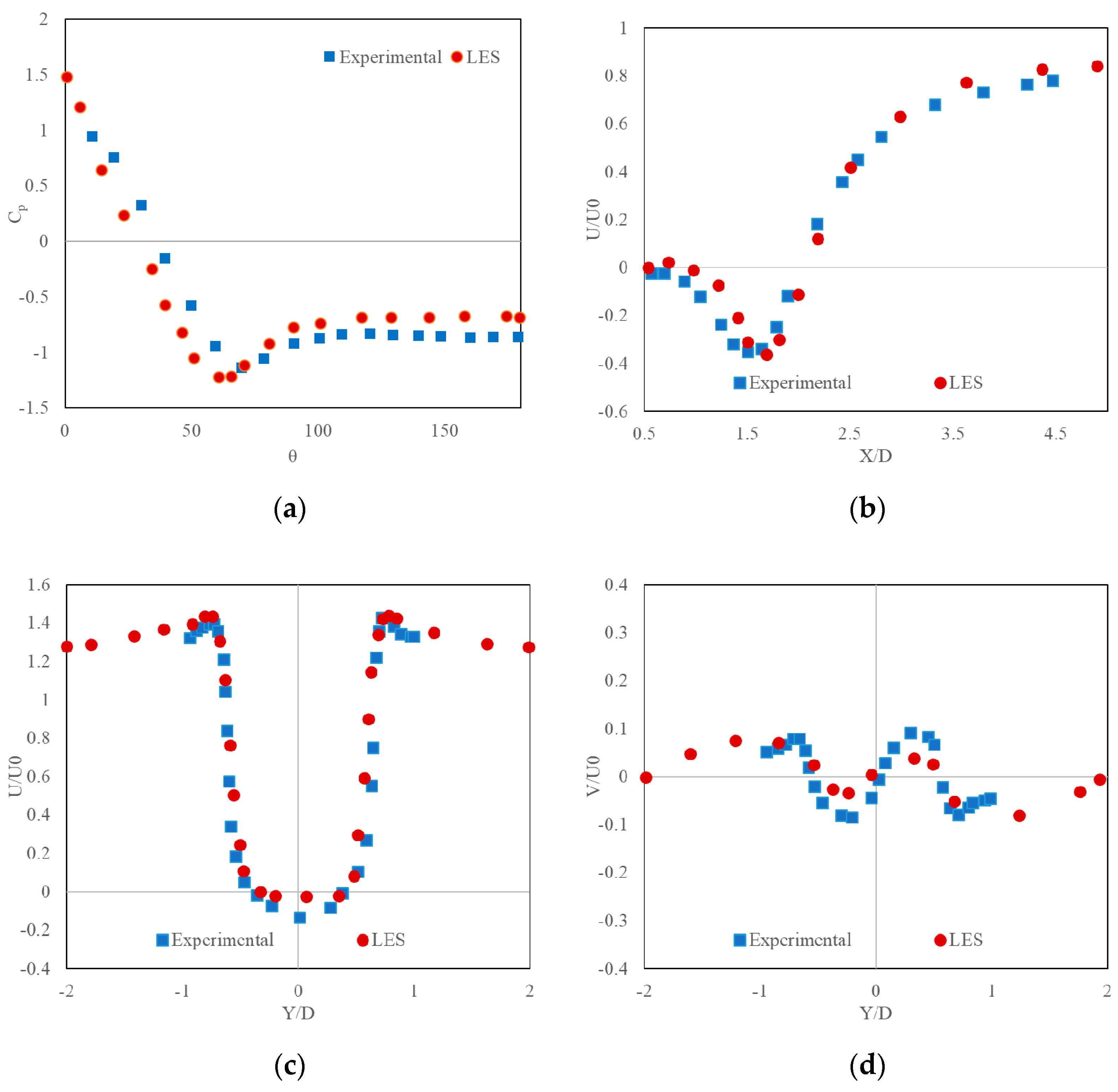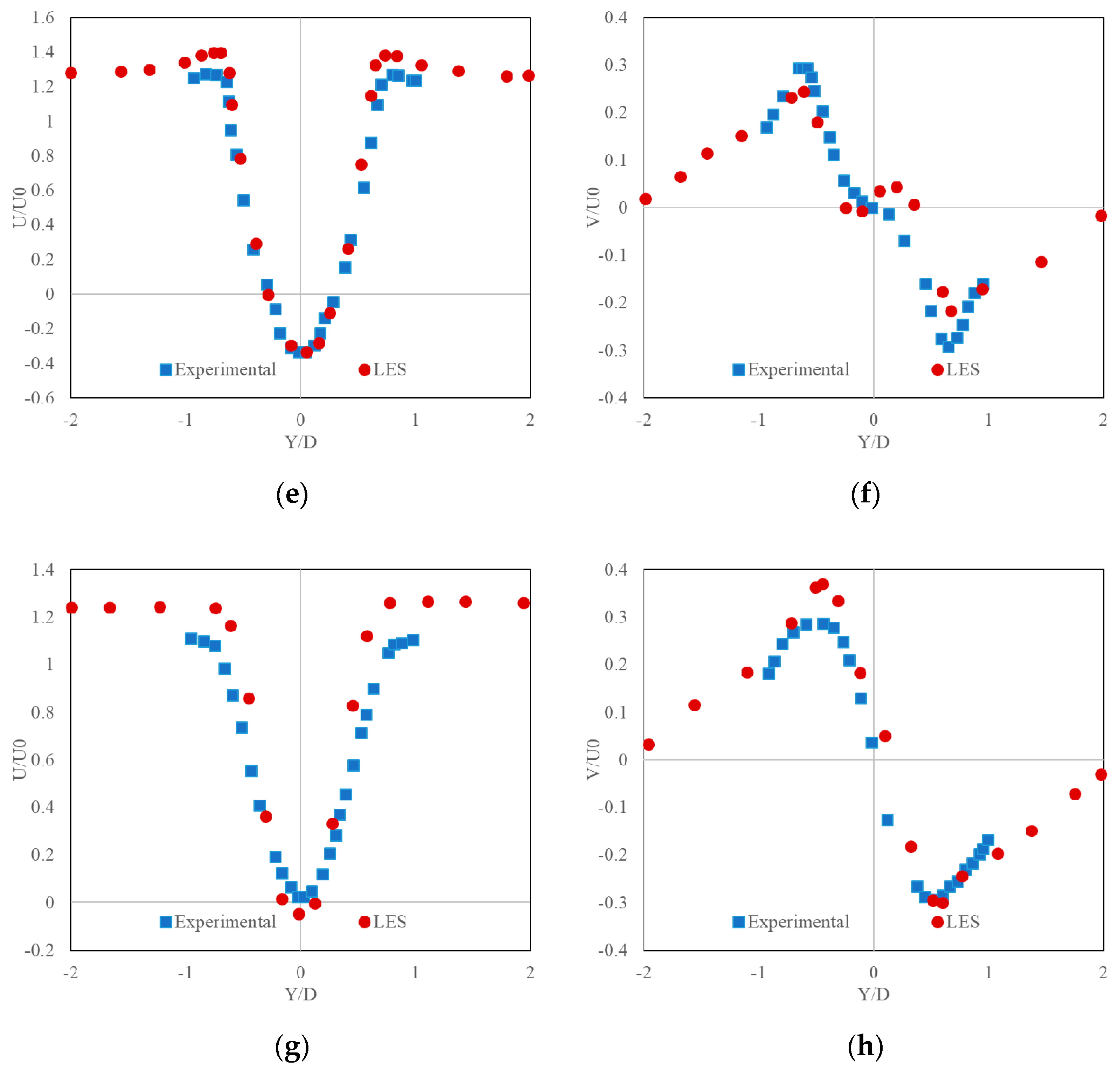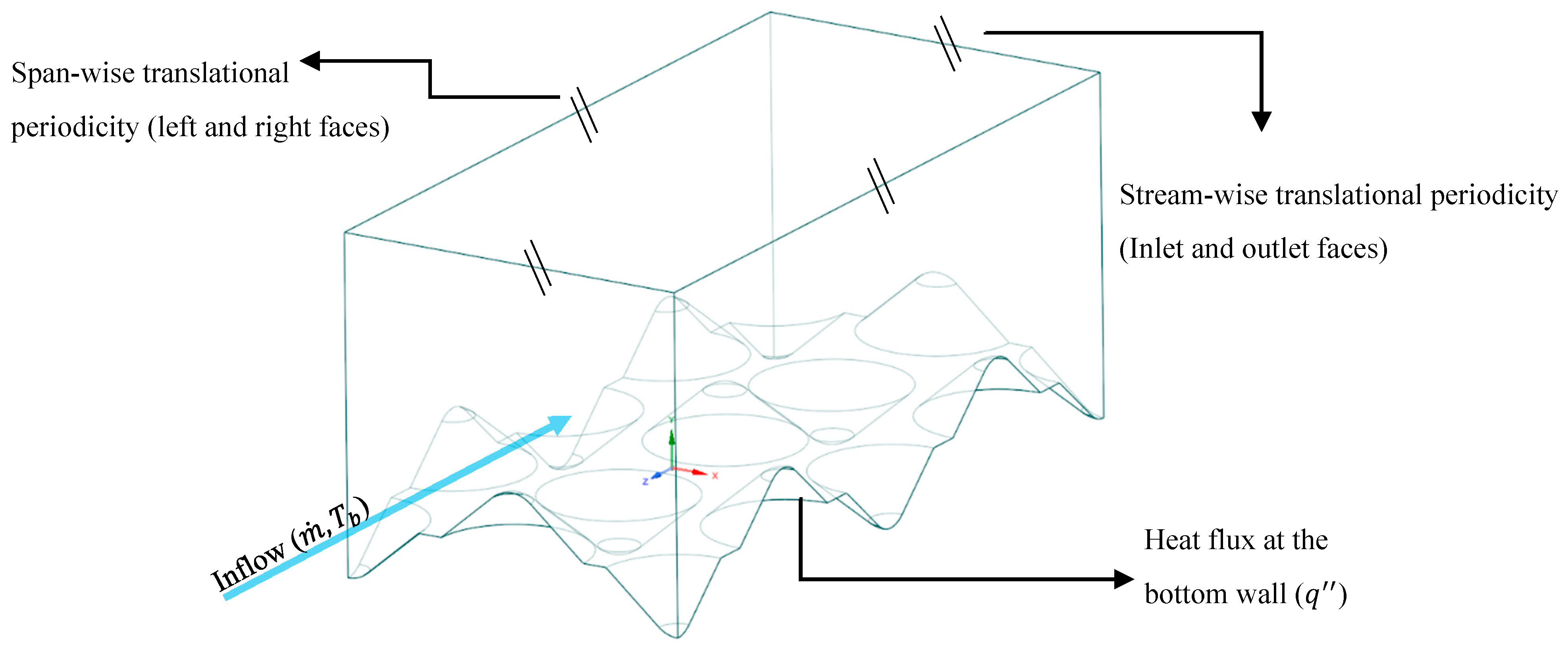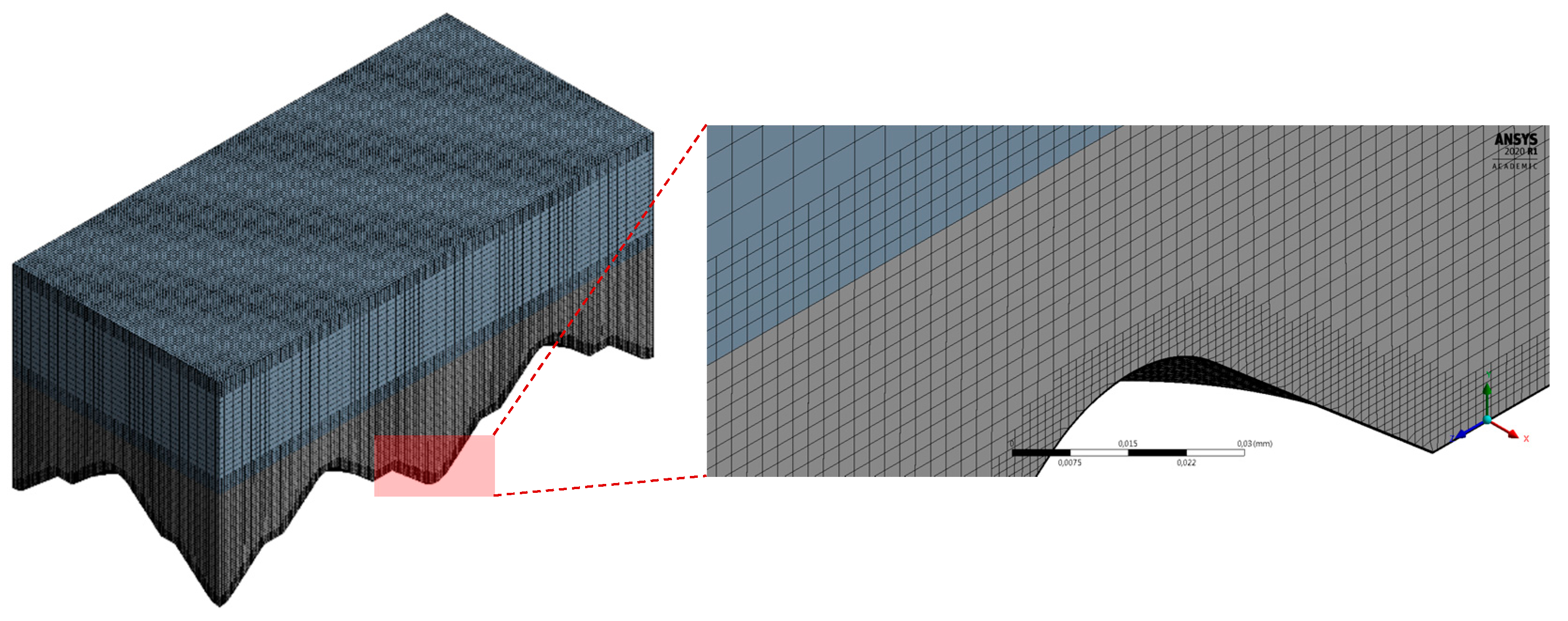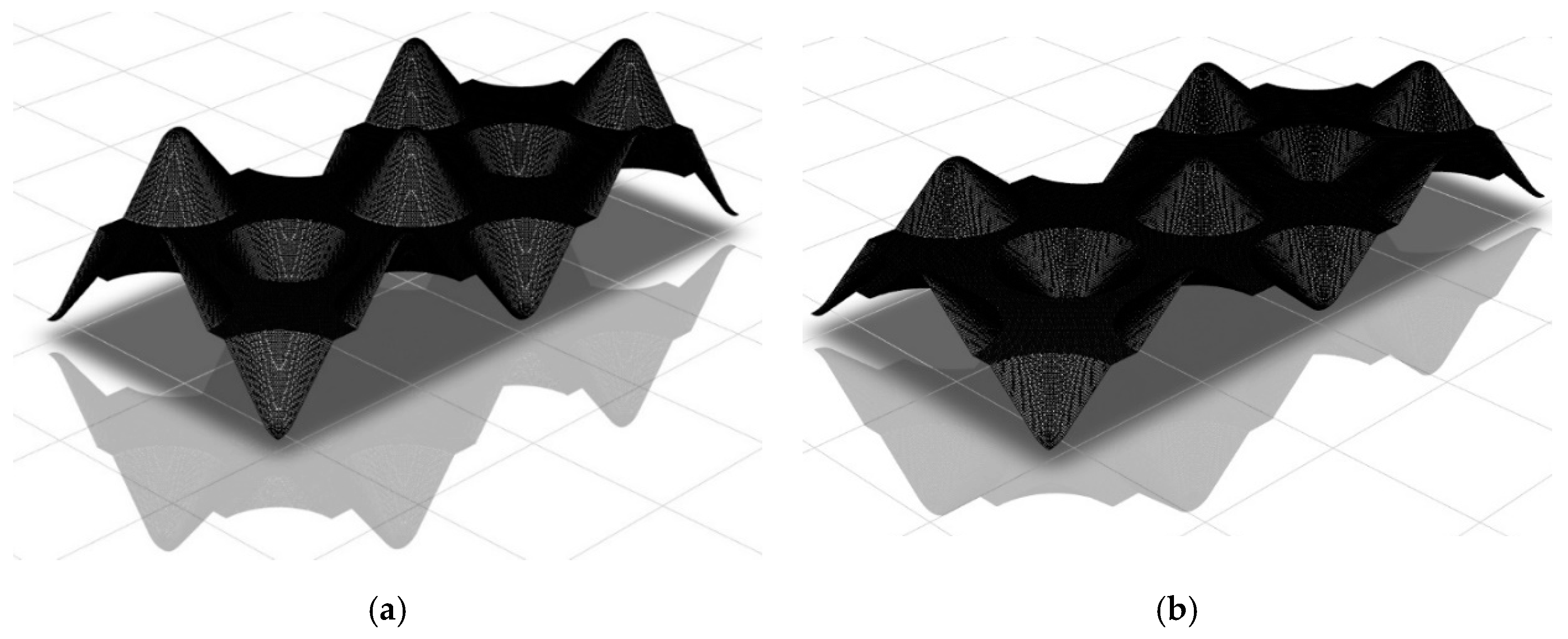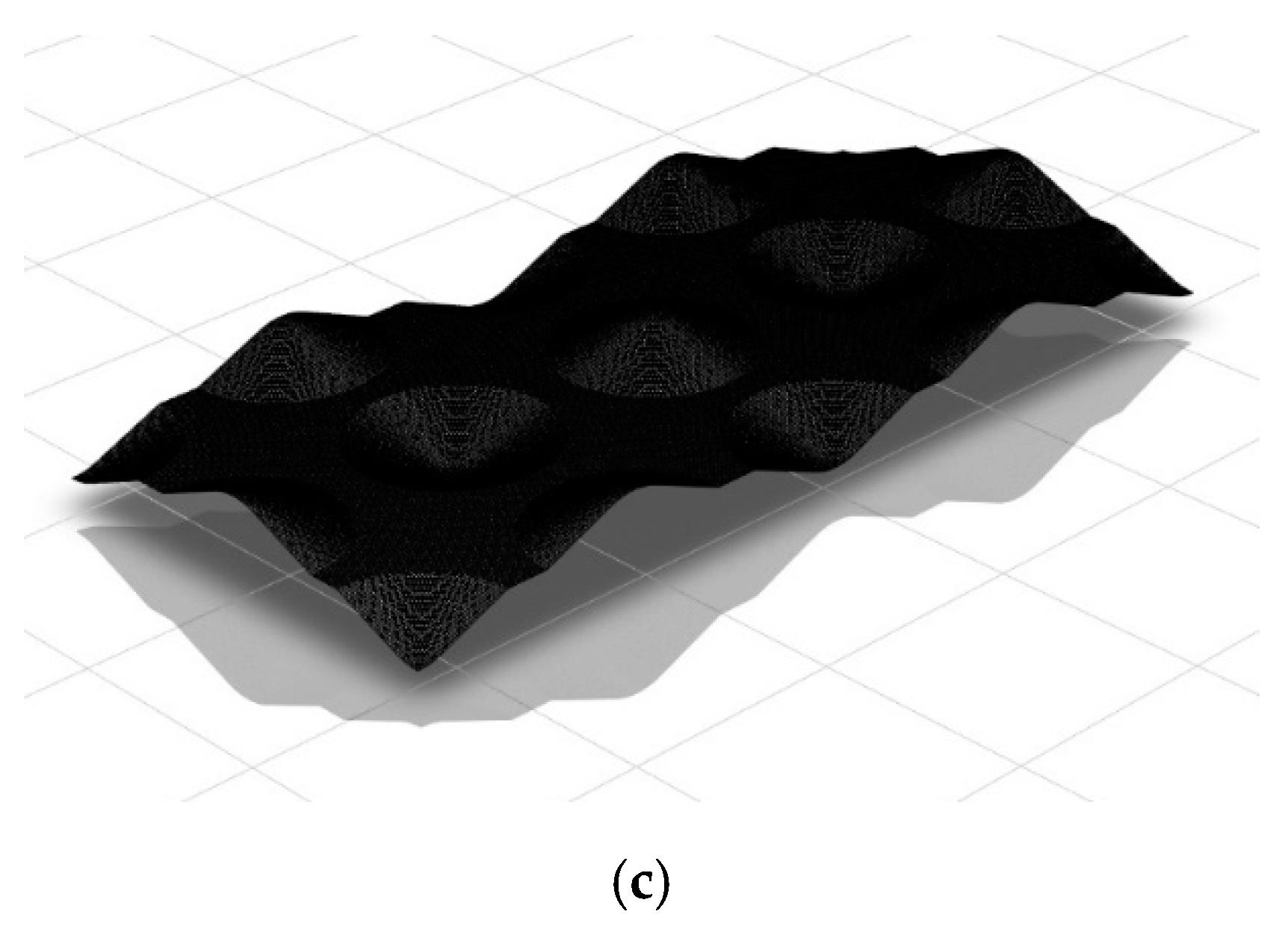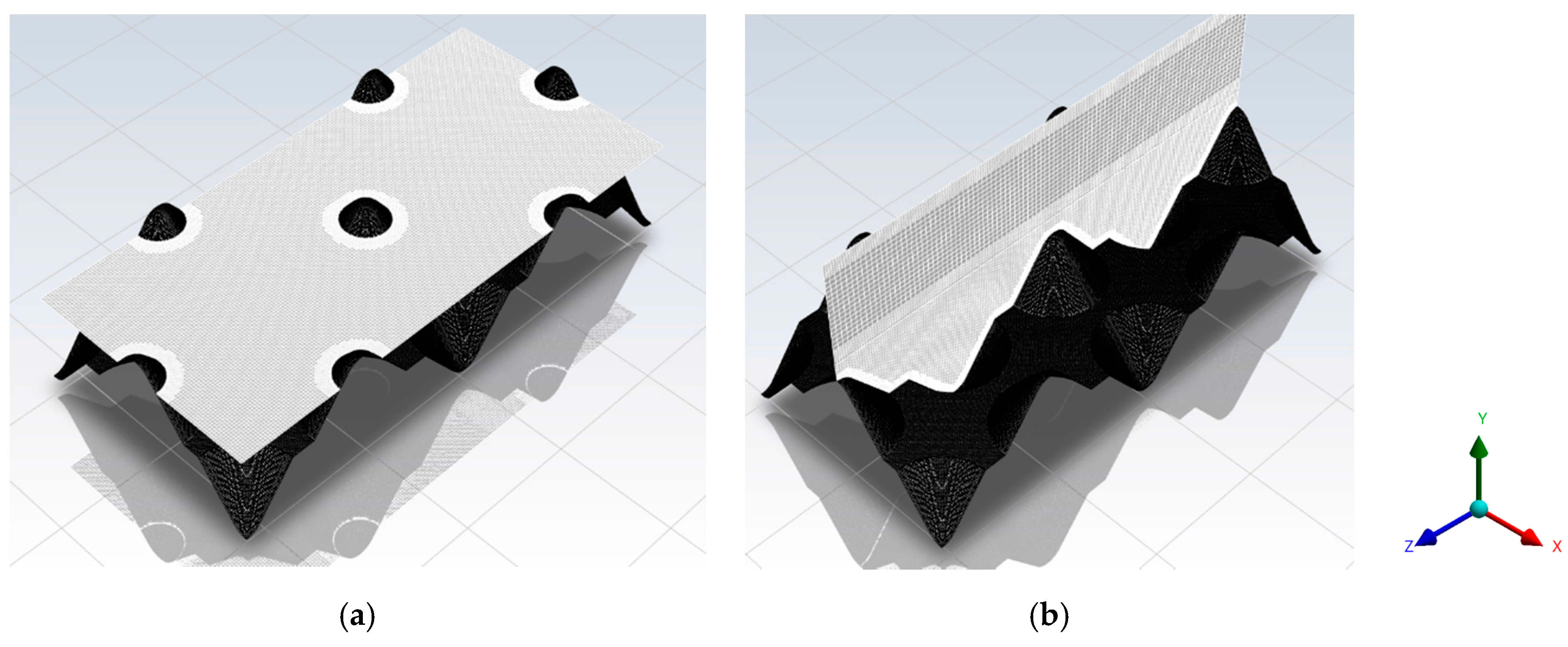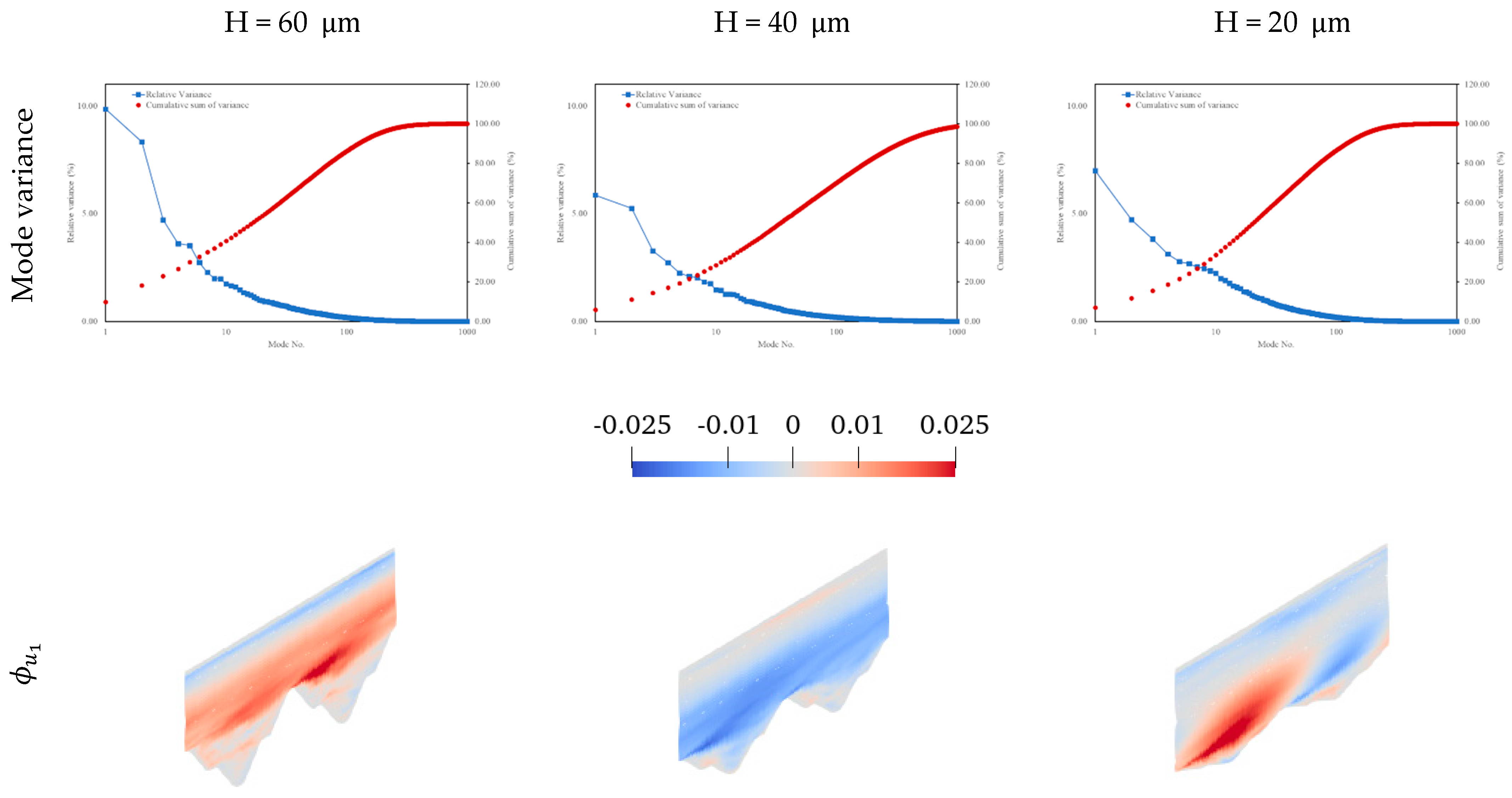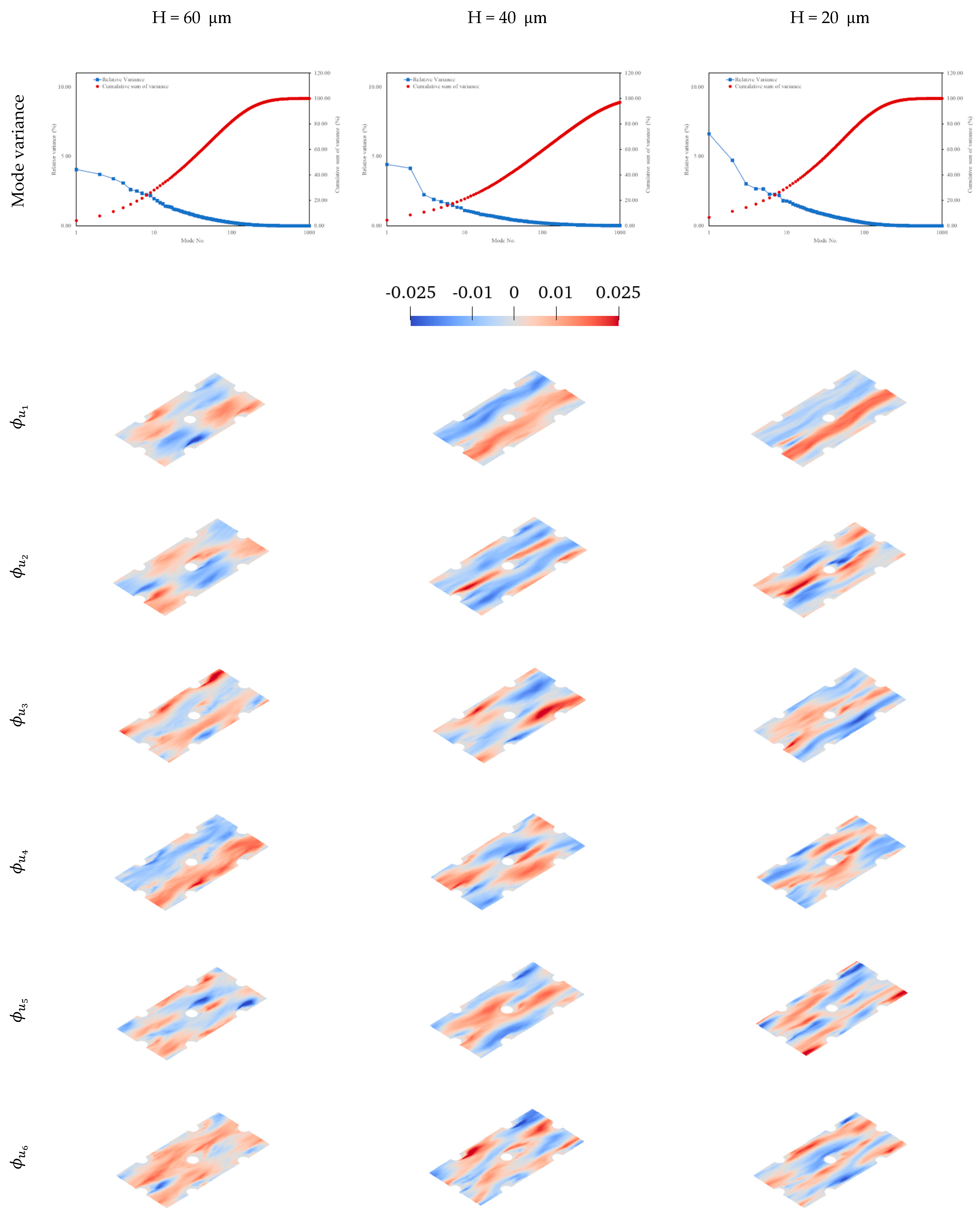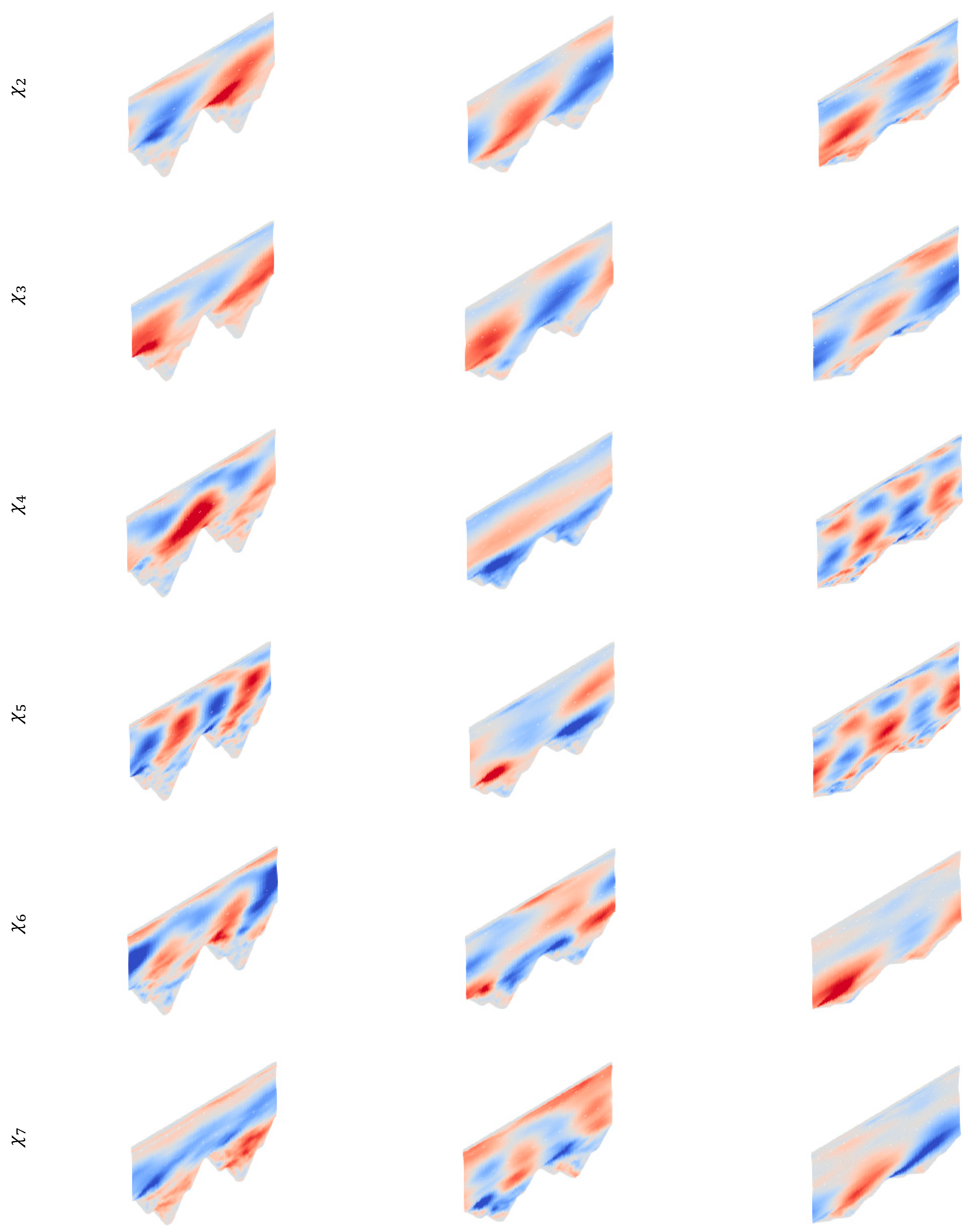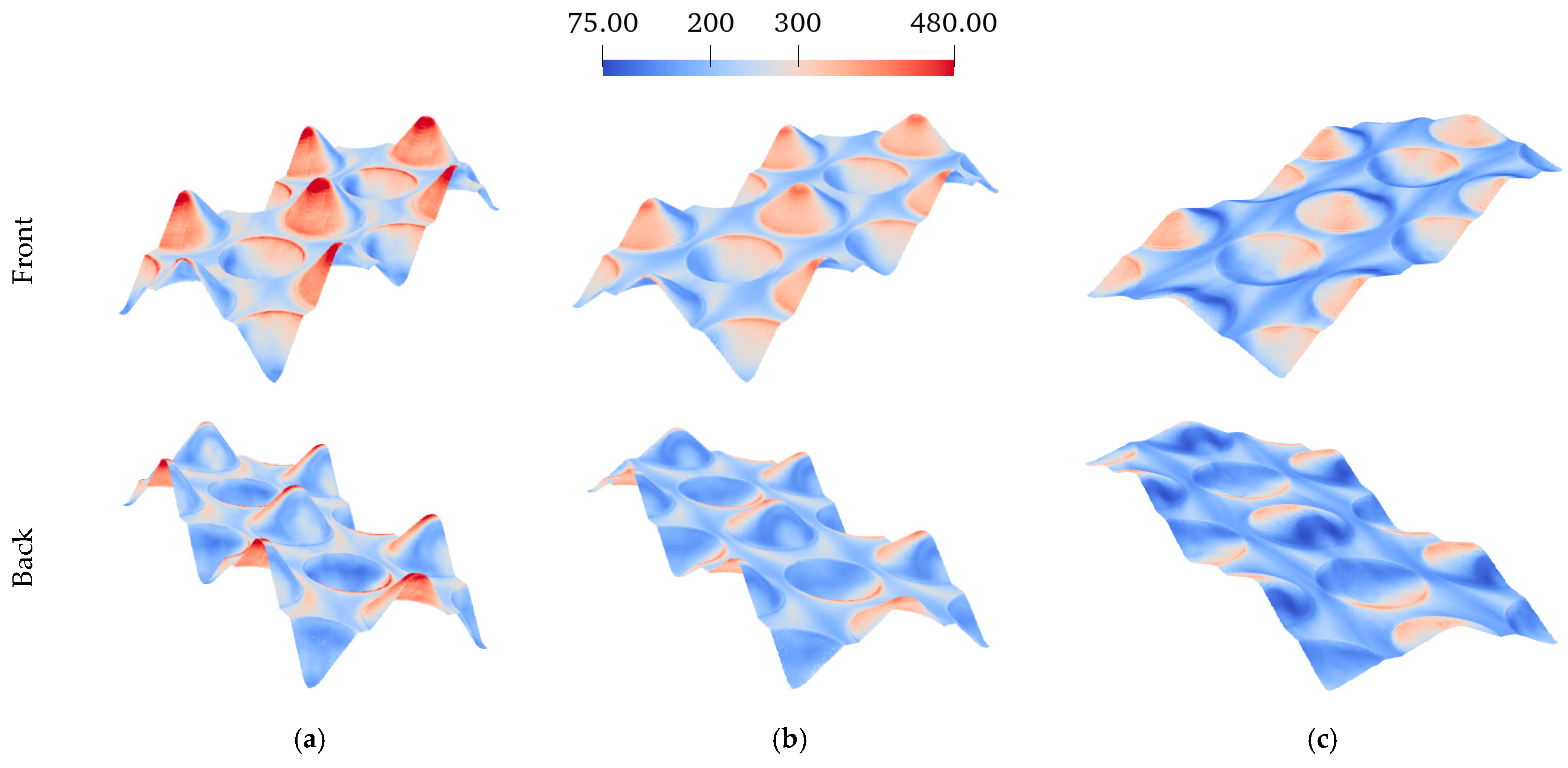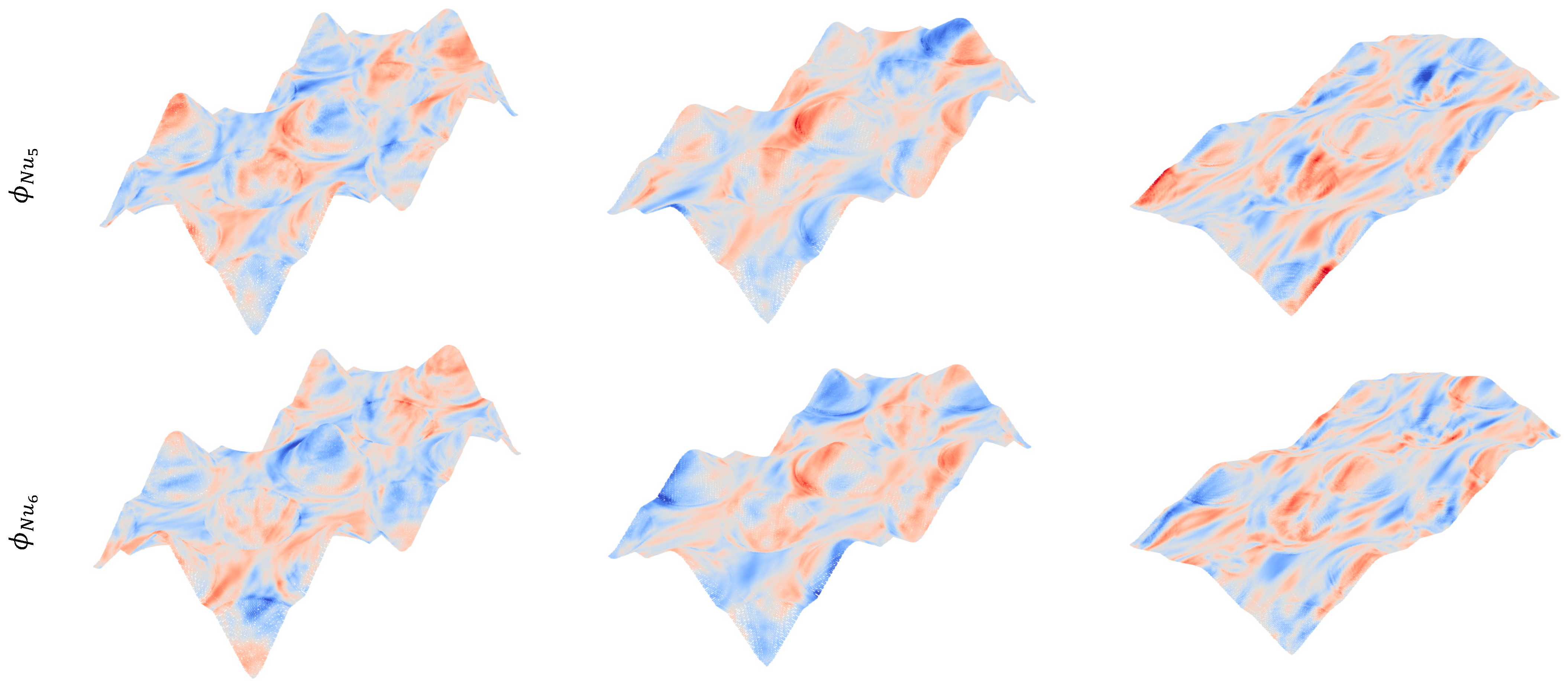1. Introduction
The trending additive manufacturing 3D printing method has been recognized as a solution to manufacture light-weight/compact heat exchanging devices with minimized material waste and facilitation of freedom in designing complex elements. Generally, the technology applies the additive shaping principle. As a result, the three-dimensional body is made by successive addition of material [
1]. The term ‘additive’ opposes the conventional ‘subtractive’ manufacturing methods, where selective removal of material is used to build the specific shape of bodies. Examples are milling, turning, and drilling [
1]. In fact, in additive manufacturing, a part is built by layer-by-layer material addition, minimizing the overall waste of raw material [
2]. Selective laser sintering, selective laser melting (very similar to selective laser sintering and differing primarily in the materials they use), electron beam melting, and direct metal laser sintering are the additive manufacturing methods dealing with metals [
3,
4].
One feature of 3D-printed heat exchanging devices that is important to thermal performance is the minimization of contact thermal resistance caused by conventional attachment of elements on surfaces [
4]. Aside from the plus points, the challenges of the additive manufacturing must be considered; overhang printing, removal of supporting structures, compatible raw materials, and minimization of the overall costs can be named as a few [
2]. In addition to the mentioned positive and challenging features, the process-induced surface roughness of additive manufacturing-enabled materials has become a topic from the perspective of fluid mixing and heat transfer consequences [
5].
The growing trend of 3D printing technology in manufacturing heat exchanging and thermal management devices on the one hand, and the naturally rough surface of the 3D-printed parts on the other hand make the study of the surface roughness effect on the thermo-hydraulic performance of additively manufacturing heat exchangers a critical topic. Stimpson et al. [
5] evaluated the surface roughness produced by the direct metal laser sintering process and measured its influence on flow losses and convective heat transfer through rectangular minichannels. Their work contains experimental data to study the overall performance of the rough surface in terms of the pressure loss and heat transfer coefficient. However, the detailed study of flow/thermal behavior is missing. The numerical study of rough surface effects on thermo-hydraulic performance has been conducted through both averaged models and detailed flow study methods, such as direct numerical simulation (DNS) and large eddy simulation (LES). Isaev et al. [
6] provided a numerical study based on Reynolds averaged Navier Stokes (RANS) turbulence modelling on vortex heat transfer enhancement in the presence of oval-trench surface dimples. The focus of this study was on the mechanism of secondary flow restructuring and heat transfer enhancement due to the formation of vortex structures in the dimples and spiral vortices in behind. Despite the undeniable strength of RANS/URANS in providing desirably fast study of engineering cases in the presence of a turbulent flow regime, there are research items reporting unrealistic results obtained by such models in comparison to the scale-resolving LES model and DNS. Turnow et al. [
7] provided a study on the flow structures and heat transfer in a staggered array of dimples on a surface in the presence of turbulent flow. They reported the flow structures determined by LES inside the dimple as chaotic, containing a wide range of scales where coherent structures are hard to detect. The applied POD showed tornado-like flow structures, and the different geometrical configurations of the dimples on the surface were shown to have considerable capacity to control the dimple-induced flow mixing.
Among the methods of analyzing the numerical/experimental data of turbulent flow thermal fields, POD has attracted considerable attention. Lumley [
8] proposed this method in the field of fluid dynamics. The primary idea was to represent the complex turbulent flow organization using a set of deterministic functions. In this case, each of the functions contains a share of total turbulence kinetic energy. Eßl et al. [
9] employed POD analysis of the gas-jet wiping process in hot-dip galvanizing. Using the decomposition analysis, they extracted the energetic flow modes of the flow. The identified energetic POD modes showed flapping and axial fluctuations of the jet core length. Extended-POD (EPOD) developed by Borée [
10] is the method to correlate two quantities using the same temporal basis. In this method, the modes of one generic quantity are found by solving the eigenvalue problem for the other quantity. Lohrasbi et al. [
11] provided a study on the correlation of flow and temperature fields for the domain with vortex generators of different angles of attack responsible for causing different signals within the computational domain. In this work, a spatial consideration was expressed to be adopted as the prerequisite for domain selection to ensure uncontaminated correlation study by EPOD.
In the present paper, an analysis of the thermal/flow behavior of a natural surface roughness topology arising in additive manufacturing from the perspective of modal decomposition analysis of flow and thermal fields is targeted. To the authors’ knowledge, the detailed study of flow mechanisms and thermal consequences over 3D-printed surfaces is missing in literature, and with the growing trend of 3D printing technology, understanding the flow/thermal aspects of such surfaces becomes crucial. Therefore, in the present study, the scale-resolving turbulence model in the framework of LES along with POD/EPOD methods are used to extract the coherent structures and study the thermal–flow correlation. The dominant energetic flow modes and the thermally important modes are extracted, and the behavior of the natural roughness model from the thermo-hydraulic perspective is discussed. The surface roughness in this work is assumed as cone-shaped peak/valley structures at three levels of heights with regular placement on the surface ignoring the randomness of height/placement of the roughness elements in the real rough surface. The paper is structured as follows. Firstly, the employed method is described and validated. Secondly, model description is provided. Thirdly, the results of the velocity POD/EPOD study are provided for the roughness model, and the modes are described. Finally, POD is applied on the Nusselt field in order to examine the footprint of the flow modes on the modes corresponding to the heat transfer coefficient on the rough surface.
2. Methodology
ANSYS Fluent 19.1 is used to study turbulent flow and heat transfer. For this, Large Eddy Simulation is adopted whose governing equations are found by filtered Navier–Stokes equations in either Fourier space or configuration space, so that eddies smaller than the filter width or grid spacing are filtered out. Consequently, the obtained governing equations represent the dynamics of large eddies. For this, the filtered variable is defined by
, where overbar denotes the filtered field,
represents the fluid domain, and
is the filter function determined based on the volume of the computational cell [
12]:
where
and
represent filtered enthalpy and temperature, respectively. The subgrid-scale turbulence models for modelling subgrid-scale stresses in ANSYS FLUENT use the Boussinesq hypothesis as in the RANS models. The subgrid-scale turbulent stresses are calculated by:
where
is the subgrid-scale turbulent viscosity and
is the rate-of-strain tensor for the resolved scale:
Eddy viscosity is modelled by the so-called wall-adapting local eddy-viscosity (WALE) model:
where
represents the von Karman constant (0.41),
represents the distance to the closest wall,
is the WALE constant (0.325), and V is the volume of the computational cell.
The working fluid is water/glycol (50-50) with the thermo-physical properties provided in
Table 1.
Validation of the LES calculation is done as shown in
Figure 1. For this, a turbulent flow over a cylinder at Re = 3900 is adopted to check the validity of the method in predicting the separation of the shear layers in the presence of an obstacle, compared with the experimental data provided by Parnaudeau et al. [
13].
Figure 1 indicates acceptable accordance of the LES-based simulation results considering the span-wise periodicity with the experimental data [
13].
Proper orthogonal decomposition—developed by Lumley [
8] as discussed before—has the capability of extracting the coherent flow structures and ranking the flow modes based on the energy content. In fact, each one of these POD modes contains a share of the total turbulent kinetic energy (TKE) of the flow field. Besides, the modes are ranked based on the energy content. The input of POD is the collected transient field data in the domain of interest by a high-enough number of snapshots. To apply POD on the fluctuating part of velocity, the following decomposition is the starting point of the calculations [
14]:
where
represents the velocity field (
=
to
),
is the number of snapshots, and
is the spatial coordinates (
= 1 to
), where
is the number of spatial positions. The fluctuating part of the velocity field can be represented by a linear set of space-dependent spatial modes
and the corresponding purely time-dependent temporal coefficients
:
According to the method of snapshots [
15], spatial POD modes and temporal coefficients can be calculated based on the eigenvalues (
) and eigenvectors (
) of the
correlation matrix (
) [
9]:
The temporal coefficients corresponding to the POD modes are calculated as follows:
The spatial modes satisfy the orthonormality condition as follows:
The spatial modes are calculated as follows:
Note that each mode contains a share () of total turbulent kinetic energy.
Borée [
10] proposed extended proper orthogonal decomposition (EPOD) to conduct correlation analysis between two vector fields or scalar fields, e.g., to study correlation between a flow field and temperature field. To achieve this, the eigenvalue problem for one quantity is solved. Following this, the obtained set of eigenvectors is used to find the modes of the other quantity (in this case, correlation is assessed between the temperature and flow fields). The correlated EPOD modes are hence found by:
where
is the field whose EPOD mode is to be calculated. The correlated field can be found using the EPOD mode [
14]:
Additionally, the uncorrelated field can be found by subtraction from the original field:
3. Model Description
Based on the roughness topology provided in [
5] corresponding to a part manufactured by direct metal laser sintering, the roughness model for the current POD/EPOD-based study is considered as cone-shaped peaks/valleys at three levels of heights (at each level, the roughness elements are of the same height) with a fixed base diameter and regular placement of the roughness elements on the surface as shown in
Figure 2,
Figure 3 and
Figure 4. It must be noted that the randomness of geometrical parameters corresponding to the roughness elements and their placement, which is naturally arising in the real surface roughness topology, is not considered in the model. In fact, the model takes into account the dominant roughness elements as cone-shaped peaks/valleys to extract the dominant flow mechanisms governing the heat transfer from the rough surface. The investigated cases in this study include roughness heights of 20
, 40
, and 60
corresponding to a height-to-base diameter ratio of
and
, respectively. The span-wise and stream-wise distance between the cone peaks in the cone-shaped roughness model are assumed as 127.8
and 134.0
, respectively. The same is used for the stream-wise and span-wise distance between valleys. The computational domain and the applied boundary conditions are provided in
Figure 2, and the three levels of roughness are illustrated in
Figure 4.
As shown in
Figure 2, stream-wise and span-wise periodicity is considered for the computational domain, and the mass flow rate (
) in the stream-wise direction is specified along Z, with a specific inflow bulk temperature (
). The bottom wall is subject to constant heat flux (
). The top wall is taken to be adiabatic with a no-slip condition. The mass flow rate over the periodic domain corresponds to Re = 1.26
, where the Re is calculated based on the height of the periodic domain [
7].
To give an overview of the generated mesh and corresponding resolution, the three-dimensional mesh for the periodic domain studying the roughness effect for the mid-level of roughness is shown in
Figure 3. Cut-Cell Meshing technology is used in ANSYS-Meshing in order to achieve the desired near-wall mesh refinement with close-to-one aspect ratios. For the illustrated mesh, the total number of cells is
and the near-wall mesh resolution is
14.2 and
0.20, where the provided values for
,
, and
are the facet maximum values representing the stream-wise, wall-normal, and span-wise resolutions, respectively. In more detail,
represents the non-dimensional wall distance for a wall-bounded flow defined as
, where
is the fluid density,
is the friction velocity at the nearest wall, y is the distance to the nearest wall, and
is the local dynamic viscosity of the fluid. Moreover,
are calculated as the square root of the multiplication of
and face area magnitude, i.e., the magnitude of the face area vector for the non-internal faces, divided by the cell wall distance, i.e., the distribution of the normal distance of each cell centroid from the wall boundaries [
16]. It is noteworthy that the difference in the resolution report of the wall-normal and stream-wise directions is due to the very thin inflation layers.
Menter’s SST k-ω [
17] is conducted as a precursor RANS simulation to identify the suitable mesh resolution, and once this is done, the time step size is estimated. The bounded second-order implicit method is used for the transient formulation, and the iterative time advancement method is applied in the entire calculation. The LES calculations are initialized by the converged RANS steady solution with a small time step size corresponding to Courant numbers as low as 0.1, and a high number of iterations per time step (as high as 100). Following this, the time step size is ramped up to CFL
10, and the number of iterations per time step is also reduced to 20. During this time, the domain is washed at least once. The required time duration is roughly determined by the channel length and flow characteristic velocity. Finally, the time step size is ramped down to CFL around one up to the statistically averageable state. Once this is reached, the snapshots containing instantaneous thermal/flow fields are exported. The final time step used in this procedure is
, and the maximum No. of iterations per time step is 100 at the beginning and 20 when exporting snapshots. The total No. of time steps for exporting snapshots is 12,000 with 4 as the data exporting frequency. The sub-grid scale model is the WALE model with
= 0.325. The SIMPLE scheme is used for pressure-velocity coupling. The spatial discretization of the gradient, pressure, momentum, and energy is done by least squares cell-based, second order, bounded central differencing, and second order upwind, respectively.
For the modal decomposition analysis, the snapshots of the flow/thermal fields are reported on the horizontal and wall-normal stream-wise planes as illustrated in
Figure 5. The horizontal plane in all cases is located at
, where
is the peak height, and the wall-normal plane is located at the middle of the periodic domain along the X-axis at X = 0 as shown in the figure. In the present study, the shown 2D planes are used to export the flow/thermal data to conduct the modal decomposition analysis at a reduced computational cost in terms of input files. The limits of this approach must be considered; specifically, the mixing between the flow mechanisms observed in these two planes and the absence of the out-of-plane velocity component affects the analyses. Modal decomposition study of 2D planes extracted from the fluid domain has been used in numerous studies (see [
18,
19,
20]) According to Meyer et al. [
20], POD study conducted on planes would agree well with the “true” three-dimensional analysis as long as the plane contains the important phenomena in the flow. Accordingly, flow/thermal snapshots in this paper are exported on a horizontally mounted plane in addition to the wall-normal stream-wise plane so as to consider the span-wise mixing effect in the horizontal plane that is not observed in the stream-wise wall-normal plane.
5. Conclusions
The conducted study investigated thermo-hydraulic behavior of a three-dimensional model representing a natural roughness profile observed in additive manufacturing. The surface roughness model is assumed as cone-shaped elements at three levels of height and regular placement of roughness elements as the major roughness structures playing a role in the flow/thermal performance of the system. LES was used to provide detailed flow/thermal fields in the transient form. The transient data were imported into modal decomposition analyses, i.e., POD/EPOD, to extract the energetic and thermally important flow modes. The obtained results indicated that in general, the flow mechanisms responsible for thermal transport are von Kármán in horizontal planes and Kelvin–Helmholtz in stream-wise wall-normal planes. A comparison was made between the POD/EPOD results of the three levels of roughness. Minimization of the dead areas corresponding to hot spots in the micro-scale roughness profile is of crucial importance. This is because regardless of the macro-scale flow mixing promoters, the high number of local dead fluctuation zones containing trapped flow acting as an insulator due to the lower thermal conductivity of common coolants in liquid/air cooling-based devices would reduce the overall performance. This is where roughness can act against the heat transfer purpose. Based on this, the surface roughness manipulation must act in a way that this effect is minimized. The recommendation is to consider the average height-to-base-diameter ratio as the thermal consideration along with the arithmetic average roughness for the design of heat exchangers to be realized by additive manufacturing. While the high ratio roughness benefits from the plus points induced by the high-rise peaks, the thermally inactive dead valleys have a negative effect. At the mid values of this ratio, the high number of local dead areas is reduced, and it still benefits from the shown mixing mechanisms by peaks. It is noteworthy that in the case of a fully smooth surface, the role of von Kármán-induced mixing in horizontal planes and Kelvin–Helmholtz mixing in stream-wise wall normal planes fade. In this case, the transport would be on the shoulder of sweep/ejection mechanisms taking place on smooth surfaces. Finally, it must be noted that the surface roughness model in this work is based on cone-shaped peak/valley structures, so that compared to the real rough surface, the random geometrical parameters of each roughness element and the randomness of placement of roughness elements are absent. Future work is to be conducted on a real 3D-printed surface roughness sample, so that the CFD domain is reconstructed using the point cloud extracted by computed tomography scanning of the rough surface, and the instantaneous flow/thermal fields to be imported into the established POD/EPOD study.
